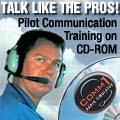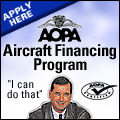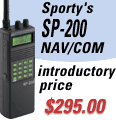| Advertisers
       
Do not reply to this e-mail. Got news? Contact ePilot. Having difficulty using this service? Visit the ePilot Frequently Asked Questions now at AOPA Online or write to [email protected].
Aircraft Owners and Pilots Association
421 Aviation Way
Frederick, MD 21701
Tel: 800/USA-AOPA or
301/695-2000
Copyright � 2001 AOPA. | Training Tips
| PRACTICING CROSSWIND LANDINGS
It is traffic-pattern practice time at your local airport. Your flight instructor is aboard, the wind is blowing down one of the field's two runways, and a good portion of your flight will be dedicated to landing in that nice steady wind.
 But which runway is the best choice for your session? For any student pilot who is approaching the solo phase of training, nearing cross-country flying, or perhaps the private pilot flight test, an old adage still applies: "There is no such thing as too much practice of crosswind landings." Sure, warm up with a couple of nice touchdowns on the runway directly aligned with that pleasant 10-knot breeze. But then, announce your intentions on the Common Traffic Advisory Frequency, or make your request to the control tower, and work the crosswind pattern for a while. There are few better environments in which a student pilot can develop–or demonstrate–having acquired a true "feel" for flying. But which runway is the best choice for your session? For any student pilot who is approaching the solo phase of training, nearing cross-country flying, or perhaps the private pilot flight test, an old adage still applies: "There is no such thing as too much practice of crosswind landings." Sure, warm up with a couple of nice touchdowns on the runway directly aligned with that pleasant 10-knot breeze. But then, announce your intentions on the Common Traffic Advisory Frequency, or make your request to the control tower, and work the crosswind pattern for a while. There are few better environments in which a student pilot can develop–or demonstrate–having acquired a true "feel" for flying.
The variable conditions presented by a crosswind approach make demands on your technique like no other phase of flying. Even if the wind remains steady in direction AND velocity from pattern altitude to touchdown (unlikely) the control inputs you must employ to keep your pattern orderly–all while changing configurations and airspeeds as you progress from downwind through base to final approach–will make you wring more performance out of your trainer than any into-the-wind approach. Can there be too much crosswind? (See Too Windy? ).
Suppose you are performing a side-slip landing technique, in which you bank into the wind with aileron and maintain longitudinal alignment with rudder pressure. Even in a steady wind, changing airspeed or flap settings as you near the runway will require you to vary your control inputs on the rudder and aileron; if the wind is gusty, flight controls may be in constant (if gentle) motion. If it is a crabbed approach you have selected with the intention of "kicking" the airplane straight before touchdown (see The Kickout Method ) your crab angle will also require adjustment as your airspeed changes to maintain the desired track, even if the wind speed and direction do not change. But more than likely, ALL these components will be in flux during your approach, and it will be up to you to meet the challenge.
This, after all, is the "real world" of aviation, and it is there to be dealt with by new trainees and old pros alike. The good news is that the wisdom of all this experience is there to be tapped by the newcomer (See Landing Proficiency ), so by all means delve into the continuing discussion of technique and experience, and it won't be long before you are contributing your observations to the ongoing conversation. Not only will this extra practice make you a safe, competent pilot–but when it comes time to take your flight test, meeting the requirements of the Practical Test Standards which mandate that landings be executed "with no side drift, and with the airplane's longitudinal axis aligned with and over the runway centerline" will be as natural to you as those early landings on that other runway–the one down which the wind always seems to be blowing.
| Accessing AOPA Online
| As an AOPA Flight Training Trial Member, you have access to all of the features within AOPA Online. If you have received a copy of the magazine or your membership credentials in the mail, log in using your eight-digit member number, which is also your username. If you have not yet received your number, please call AOPA Member Assistance at 800/872-2672 weekdays between 8:30 a.m. and 6 p.m. Eastern for assistance.
| Flight Training News
| NORTH AMERICAN-BUILT DIAMOND STAR MAKES FIRST FLIGHT
Diamond Aircraft says it's "full steam ahead" for the IFR-equipped DA40-180 Diamond Star. The four-place aircraft–similar to Diamond's two-place DA20 models, which are frequently used as trainers–should offer an easy transition to pilots who learn to fly in DA20s. The first North American-built Diamond Star recently made its maiden flight. It will be delivered to Empire Aviation of London, Ontario. Diamond plans to ramp up production of the Diamond Star to eight aircraft a month by July 2002, and expects to deliver 85 DA40s next year. See the Web site.
WOMEN IN AVIATION CONFERENCE DISCOUNT TO EXPIRE
Thousands of aviation professionals and enthusiasts participate in the annual International Women in Aviation Conference. Many student pilots and collegiate aviation students are among those attending. The thirteenth annual conference, sponsored by Women in Aviation, International, will be held March 13 to 15, 2002, in Nashville. Register by January 4 for discounted admission. For more information visit the Web site or call 386/226-7996.
| Inside AOPA
| AOPA PUSHES FOR FLIGHT SCHOOL OPERATION DURING OLYMPICS
AOPA has hand-delivered a detailed plan to top FAA officials that it believes would provide VFR access for general aviation users during the 2002 Winter Olympics without compromising security. The FAA's proposed airspace security plan would essentially shut down all of the airspace–and all flight training–in the Salt Lake City area for 19 days, beginning February 6. "The primary concern for AOPA is the impact that this (the FAA's) security plan would have on local pilots and flight schools," said AOPA President Phil Boyer. "Given the specific nature, location, and timing of the Olympic venues, it is possible for the FAA to help the GA community by implementing AOPA's recommendations for local access." To read the plan, see AOPA Online.
Changing your mailing or e-mail addresses? Click here to update.
| Training Products
| IFR COMMUNICATIONS ON DVD
IFR Communications, a Sporty's "What You Should Know" video, is now available on DVD. Produced to teach instrument students and instrument-rated pilots to communicate more professionally, the program will help prepare any pilot for flight into busy airspace. The DVD is available for $24.95 from Sporty's Web site or by calling 800/LIFT OFF or 513/735-9000.
| Final Exam
| Question: I'm about halfway through my training. Can you tell me what I might expect to do during my checkride for my private pilot certificate?
Answer: The Federal Aviation Administration (FAA) details the checkride requirements for each certificate or rating in the Practical Test Standards (PTS). The PTS is designed as the standard to be used by FAA inspectors and designated pilot examiners when conducting pilot practical tests. Flight instructors are expected to use these standards when preparing applicants for practical tests. For more information on the PTS, see AOPA Online. Click here to download the actual Practical Test Standards for the private pilot certificate.
Got a technical question for AOPA specialists? E-mail to [email protected] or call 800/872-2672.
| What's New At AOPA Online
| Check out the AOPA Air Safety Foundation's SkySpotter quiz to see how much you know about giving accurate pilot reports (pireps). See AOPA Online.
| Picture Perfect
| | Jump to the AOPA Online Gallery to see the featured airplane of the day. Click on the link for details on how to capture wallpaper for your work area. See AOPA Online. | ePilot Calendar
| Check your weekend weather on AOPA Online.
WEEKEND FLYING DESTINATIONS
Chino, California. The Air War over North Africa is a featured presentation at the Air Museum Planes of Fame January 5. Call 909/597-3722 for event information.
Lawrenceville, Georgia. A pancake breakfast takes place January 5 at Briscoe Field (LZU). Call 770/613-9501 for event information.
For more airport details, see AOPA's Airport Directory Online . For more events, see Aviation Calendar of Events
ASF FLIGHT INSTRUCTOR REFRESHER CLINICS
(All clinics start at 7:30 a.m.)
The next AOPA Air Safety Foundation Flight Instructor Refresher Clinics are scheduled in Long Beach, California; Charlotte, North Carolina; and San Antonio, Texas, January 5 and 6. For the Flight Instructor Refresher Clinic schedule, see AOPA Online.
ASF PINCH-HITTER GROUND-SCHOOL COURSES
(Pinch-Hitter courses start at 9:30 a.m.)
The next Pinch-Hitter� Ground Schools will take place January 6 in Long Beach, California, and San Antonio, Texas. For more Pinch-Hitter courses, see AOPA Online.
ASF SAFETY SEMINARS
AOPA Air Safety Foundation Safety Seminars are scheduled in Oakland, California, January 7; Santa Rosa, California, January 8; Sacramento, California, January 9; and Fresno, California, January 10. The topic is Spatial Disorientation. For more information, visit the Web site.
For comments on calendar items or to make submissions, contact Julie S. Walker at [email protected].
| |